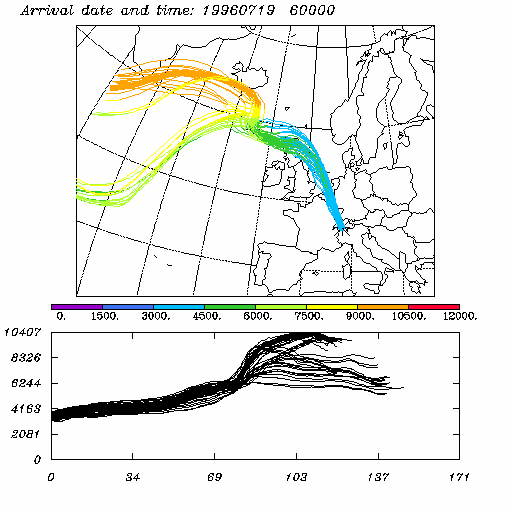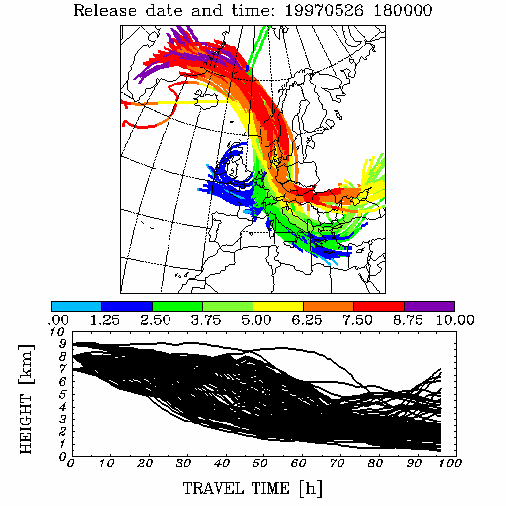

 You can download improved routines for the retrieval of FLEXTRA/FLEXPART input data from ECMWF (works also on the new ecgate server)!
You can download improved routines for the retrieval of FLEXTRA/FLEXPART input data from ECMWF (works also on the new ecgate server)!
FLEXTRA recently participated in an intercomparison of trajectory models.
![]() What is FLEXTRA?
What is FLEXTRA?
FLEXTRA is a kinematic trajectory model which can be used to calculate several different types of trajectories (three-dimensional, isentropic, isobaric, isoeta, boundary layer trajectories).
![]() What kind of input data are needed to drive FLEXTRA?
What kind of input data are needed to drive FLEXTRA?
FLEXTRA is based on data from the European Centre for Medium-Range Weather Forecasts (ECMWF). However, there also exists a model version for the Swiss/German weather prediction model. It should be not too difficult to adapt FLEXTRA to other similar data sources as well. If you have access to the ECMWF MARS database, you may download old or download new data extraction routines and a documentation written by Gerhard Wotawa, Paul James and others.
![]() What about the system requirements?
What about the system requirements?
FLEXTRA, written in FORTRAN 77, is largely platform-independent. It currently runs on SUN, SGI, HP, Compaq Alpha and LINUX workstations. The memory requirements depend on the spatial domain of your input fields and the number of trajectories you want to calculate. You need GRIB decoding software to read ECMWF input data.
![]() How good is FLEXTRA?
How good is FLEXTRA?
Well, just as good as the input data. FLEXTRA has been validated through comparison of model results to independent data using wind fields of varying spatial and temporal resolution, the tracks of CVBs, gas balloons and hot-air balloons, and using potential vorticity and specific humidity as tracers. The performance varies with the meteorological conditions, but trajectory errors on the order of 20% (or probably somewhat smaller) of the travelled distance can be expected on the average when using analyzed wind fields. There exists an ensemble option, which can be used to assess part of the uncertainty in the calculations.
![]() What does the above picture show?
What does the above picture show?
It shows an ensemble of 33 backwards trajectories terminating at the mountain peak Jungfraujoch when enhanced concentrations of ozone and 7-Beryllium and low humidity (tracers of stratospheric air) were observed. The trajectory ensemble shows a significant branch of the trajectories descending from the stratosphere in this case. The upper figure presents a horizontal projection of the trajectories with color-coded altitude, the lower one their altitude vs. travel time.
![]() Where was FLEXTRA developed?
Where was FLEXTRA developed?
FLEXTRA was developed at the Institute of Meteorology and Geophysics in Vienna by Andreas Stohl, Gerhard Wotawa and Petra Seibert. The recent updates were made by Andreas Stohl at the Technical University of Munich. Gerhard Wotawa developed the MM5 and AVN versions of FLEXTRA.
![]() Where is FLEXTRA being used?
Where is FLEXTRA being used?
Institute of Meteorology and Physics, Agricultural University, Vienna, Austria (Helga Kromp-Kolb, Petra Seibert)
Central Institute of Meteorology and Geodynamics, Vienna, Austria (Ulrike Pechinger)
Chair of Bioclimatology and Air Pollution Research, Technical University of Munich, Germany (Andreas Stohl)
Institute for Physical Geography, University of Berne, Switzerland (Evi Schuepbach)
State University of New York at Stony Brook, New York, USA (Wuyin Lin)
Dept. of Environmental Studies, University of the Aegean, Mytilene, Greece (Maria Kakaridou)
Air Quality Research, Finnish Meteorological Institute, Helsinki, Finland (Aki Virkkula)
Laboratoire de Meteorologie Dynamique du C.N.R.S., Paris, France (Vincent Daniel)
Institute for Marine and Atmospheric Research Utrecht, Utrecht, Netherlands (Geert-Jan Roelofs)
Group of Atmospheric Physics, Canary Islands, Spain (Juan P. Diaz Gonzalez)
Hellenic National Meteorological Service, Greece (Ioannis Alexiou)
Kyonggi University, Korea (Sang Jin Jeong)
Consorzio Pisa Ricerce, Italy (Giuseppe Santoro)
Deutsches Fernerkundungsdatenzentrum, Deutsches Zentrum fuer Luft- und Raumfahrt (Thilo Erbertseder)
Institute for Global Change Research, rontier Research System for Global Change, Japan (Shamil Maksyutov)
North Carolina Supercomputing Center, USA (Adel F. Hanna)
CESI s.p.a., Italy(Fabio Rocchetti)
Departamento de Matematica Aplicada, Universidad del Pams Vasco, Spain (Veronica Valdenebro)
Institute of Arctic and Alpine Research, University of Colorado, USA (Kenneth Mack)
Aeronomy Laboratory, NOAA, Colorado, USA (Steve Reid)
Comprehensive Test Ban Treaty Organisation, United Nations (Gerhard Wotawa)
Pacific Northwest National Laboratory (PNNL), USA (Cliff Glantz)
Department of Earth and Ocean Sciences, Vancouver, Canada (Paul Bovis)
Norwegian Institute for Air Research (NILU), Norway (Frode Flatoy)
Max-Planck Institute for Chemistry, Mainz, Germany (Michael Traub)
Institute for Atmospheric and Climate Science, ISAC-CNR, Italy (Federico Fierli)
Centro de Modelamiento Matematico, UMR-CNRS, Universidad de Chile (Laura Gallardo Klenner)
University of Trento - Engineering, Italy (Alessio Berto)
Finnish Meteorological Institute, Air Quality Research, Finland (Juha Hatakka)
![]() How do I get more information on FLEXTRA?
How do I get more information on FLEXTRA?
An English documentation of version 3.0 (also valid for V3.1) is available online and as a postscript file.
A documentation of the use of MM5 data for FLEXTRA is available.
![]() Are there any publications on FLEXTRA?
Are there any publications on FLEXTRA?
![]() How can I get the source code of FLEXTRA?
How can I get the source code of FLEXTRA?
You can download UNIX tarfiles of FLEXTRA versions 2.0, 3.0b, 3.1, 3.2b, 3.2c, 3.2d and 3.3d, and 3.0 for MM5 and AVN.
If you do so, please be so kind to send me an e-mail so that I can provide you with updates, bug reports, etc. Any comments on the model are highly welcome. Should some publications arise from your work with FLEXTRA, do not forget to send me a copy.
Download FLEXTRA V2.0
Download FLEXTRA V3.0b
Download FLEXTRA V3.1
Download FLEXTRA V3.2b
Download FLEXTRA V3.2c
Download FLEXTRA V3.2d
Download FLEXTRA V3.3
Download FLEXTRA V3.0 for MM5
Download FLEXTRA V3.0 for AVN
V3.3 has more efficient use of memory: For constant time step output, the parameter maxtime can be set to much smaller values than in the older versions.
V3.2d gives the CET output sorted according to longitude/latitude/altitude.
V3.2c automatically detects whether you are on a Little or Big Endian Computer and does the bit swapping accordingly.
V3.2b is faster than previous versions when many trajectories are to be calculated. The format of the output files has been changed.
V3.0b and V3.1 contain a bug which leads to (mostly small) inaccuracies at the upper and right boundaries of nested grids.
![]() Known bugs?
Known bugs?
FLEXTRA seems to run very stable. The interpolation of humidity in V3.1 was buggy, which has been corrected in V3.2. Be careful with compiler options for V3.2; gnu FORTRAN under LINUX, for unknown reasons, yields erroneous results for potential vorticity for optimization levels -O2 and -O3. More info in the README files.
![]() And if I want to have even more possibilities?
And if I want to have even more possibilities?
Try the FLEXPART model.
Please note: Access and use of FLEXTRA shall impose the following obligations on the user. The user is granted the right, without any fee or cost, to use, copy, modify, alter, enhance and distribute FLEXTRA, and any derivative works thereof, and its supporting documentation for any purpose whatsoever, except commercial sales, provided that this entire notice appears in all copies of the software, derivative works and supporting documentation.
This software is provided "as is" and any express or implied warranties, including but not limited to, the implied warranties of merchantability and fitness for a particular purpose are disclaimed. In no event shall the University of Munich be liable for any special, indirect or consequential damages or any damages whatsoever, including but not limited to claims associated with the loss of data or profits, which may result from an action in contract, negligence or other tortious claim that arises out of or in connection with the access, use or performance of FLEXTRA.

This figure shows a coherent ensemble of trajectories illustrating a deep intrusion of stratospheric air into the troposphere. The trajectories were selected from a much larger number starting uniformly on a grid by requiring them to start in the stratosphere and to descend by more than 5000 m.
FLEXTRA was recently compared to the models LAGRANTO from the ETH Zurich and TRAJKS from KNMI. The results are presented in Stohl, A., L. Haimberger, M.P. Scheele, and H. Wernli (2001): An intercomparison of results from three trajectory models. Meteorol. Applications 8, 127-135.
Generally, good agreement was found, with average deviations in horizontal positions being less than 4% of the average travel distance and 2% if the same interpolation methods are used with all three models.
Thus, from an accuracy point of view, all three models use the wind field information equally efficient.
In the above paper, results are presented for three test cases.
For the tests 1 and 3, I make the FLEXTRA results (with non-linear interpolation and 6 hours time resolution) available.
They may be used for further intercomparison studies.
Download test case 1 results
Download test case 2 results
Both files are compressed ASCII FLEXTRA output files.
Back to Andreas Stohl's Home Page
Last updated: 2 November 2001